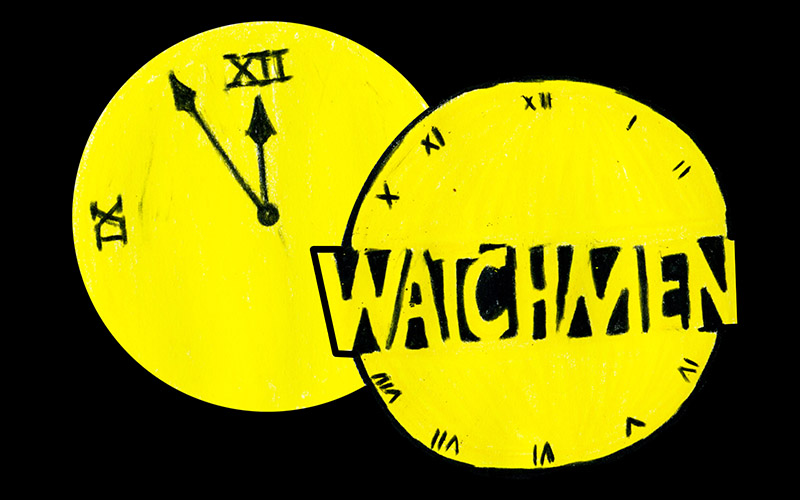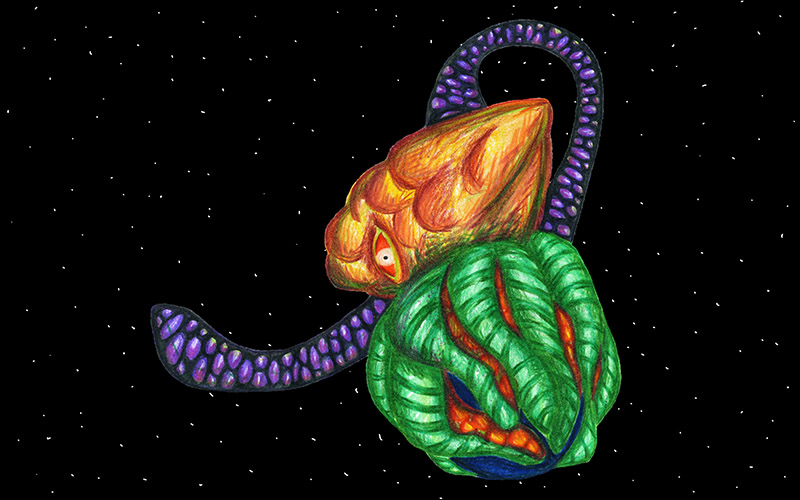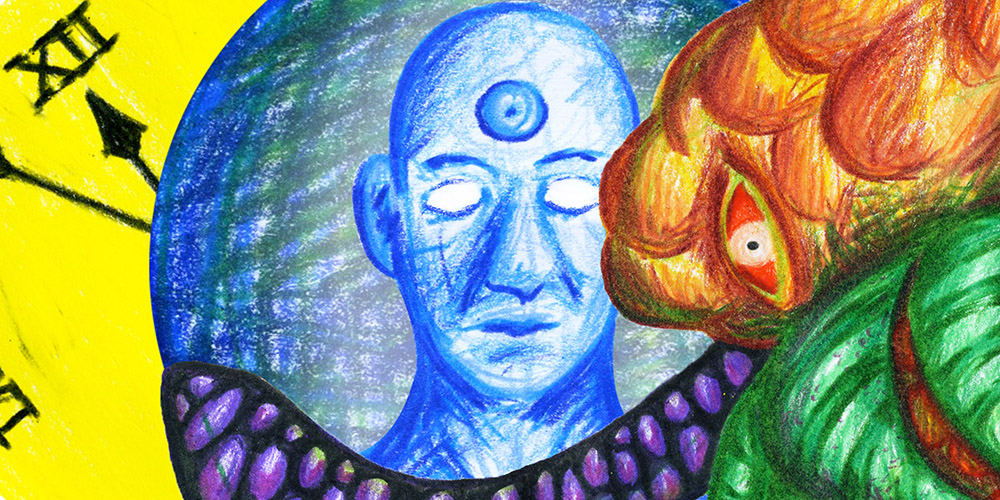The fourth episode of Damon Lindelof’s HBO series Watchmen, “If You Don’t Like My Story, Write Your Own,” opens with a song I never heard before, and closes with a recording of a song I did not know existed. My ignorance of both of these works is tied directly to the commentary Lindelof is attempting regarding race in America, the trauma lurking under America’s established historical narratives, and what makes an effective adaptation of a celebrated work. Connected to these songs’ significance are the goals of Lindelof’s adaptation of Allen Moore and David Gibbons’ celebrated graphic novel, and how the series is not only a metacommentary on what makes a good adaptation but also how the processes of musical adaptation and historical memory are interconnected.
The opening song, Dolly Parton and Kenny Rodgers’s 1982 duet “Islands in the Stream,” was totally foreign to me, until it reached the refrain:
Islands in the stream
That is what we are
No one in between
How can we be wrongSail away with me
To another world
And we rely on each other, ah ha
From one lover to another, ah ha
It was at “that is what we are” where it clicked that I had heard the refrain before, when it was sampled in Mya’s hook to Pras’s 1998 rap anthem, “Ghetto Supastar.”
Ghetto superstar, that is what you are
Comin from afar, reachin’ for the stars
Run away with me, to another place
We can rely on each other, uh-huh
From one corner, to another, uh-huh
I was eight when “Ghetto Supastar” was released, but I remember the song receiving near-continuous rotation on pop radio. Since “Islands in the Stream” was omitted from the canons of the classic rock and modern country radio stations I was raised on in suburban Ohio, I was never exposed to it until now. As a millennial with a more vested scholarly interest in classical film and TV than in music, this phenomenon of discovering that a song of my childhood derives from an older work is not new to me. For example, I only discovered that House of Pain’s “Jump Around” sampled the horn fanfare of Bob & Earl’s “Harlem Shuffle” in 2017, when the latter song was used in Edgar Wright’s Baby Driver. Wright’s sampling of “Harlem Shuffle” was tied into his aims with that film, which was a return of the car action film to its source code of 1970s Walter Hill crime thrillers.
Lindelof and his music supervisor, Liza Richardson, chose their songs with the same degree of intentionality. Like Wright with Baby Driver, Lindelof and Richardson are unearthing musical history to draw attention to the historical blind spots of younger generations, which obviously includes me. However, unlike Wright’s music trivia gamesmanship, Lindelof and Richardson connect their soundtrack choices to society’s repression of history, particularly traumatic historical events.
Lindelof’s Watchmen is an adaptation of writer Allen Moore and illustrator David Gibbons’s celebrated 1985 graphic novel, a hallmark subversion of the superhero comic. The series chronicles four decades of an alternative-reality United States in which costumed heroes are a regular presence in the United States, starting with the masked avengers of the Minutemen in the 1940s, through the 1960s Crimebusters, an attempted reboot of the masked tradition by a mostly younger generation of heroes. This era also witnessed the emergence of Dr. Manhattan, a true superhero created when a scientist is transformed by a nuclear accident into a nearly all-powerful god. Though Dr. Manhattan helps the U.S. win the Vietnam War and Richard Nixon stay as president through the 1980s, his presence creates an imbalance in the global arms race, pushing the Soviet Union to military belligerence and the world to the brink of nuclear holocaust. Only the manufacturing of a convoluted fake alien invasion by another masked hero, Adrian Veidt (aka Ozymandias), and Veidt’s sacrificial massacre of New York City to sell that invasion, unites the world and staves off the annihilation. The series ends with Dr. Manhattan moving on from Earth to create life on some distant planet, two remaining heroes, Silk Spectre #2 and Night Owl, agreeing to keep quiet about the secret, and the one dissenting “hero,” the fascistic masked thug Rorschach, is killed by Dr. Manhattan for threatening to reveal Veidt’s conspiracy. The comic series ends with the image of Rorschach’s diary lying in the mail pile of a far-right tabloid, leaving open the possibility of the secret revealed and world peace broken.

The mere fact that Lindelof’s series is an adaptation of Watchmen would subject the series to a tsunami of scrutiny by fans and critics, particularly since Moore has disowned and lambasted all screen adaptations of his works. Adding to this challenge is the fact that Watchmen was already subject to a high-profile adaptation. Zack Snyder’s 2009 film version has its defenders (Roger Ebert gave the film four stars), but the film was dismissed by many critics as faithful-to-a-fault to the original comic (Variety’s Justin Chang argued that it “is ultimately undone by its own reverence”). Snyder’s film reignited a Hollywood conversation that has been ongoing since before Gone with the Wind: whether a faithful film adaptation of a work is a “good” adaptation. It is a conversation that Lindelof, a longtime fan of Watchmen, is acutely aware of: on the back of my 2005 edition of the graphic novel Lindelof’s blurb calls the comic “The Greatest Piece of Popular Fiction Ever Produced,” indicating his longtime superfan status.
Lindelof takes on this challenge with a startling reimagining of the source text: rather than remake Watchmen, he decided to make a loose sequel of the events of the original comic. Set in 2019 Tulsa, 34 years after the staged alien invasion, Robert Redford is in his third decade as America’s president and has issued reparations to victims of racial oppression (scornfully called “Redfordations” by dissenting Whites). This has led to a terroristic backlash: police are allowed to wear masks and hide their identities from the public after a white supremacist sect called the Seventh Kalvary massacred Tulsa PD in their homes, an event later called the “white night.” As the police and FBI investigate the lynching of Tulsa’s police chief, Lady Trieu (Hong Chau), the richest woman in the world and Adrien Veidt’s unsuspecting daughter, conspires to steal away the powers of Dr. Manhattan (Yahya Abdul-Mateen II), who fell in love with a police officer named Angela Abar (Regina King) and is back on earth disguised as her husband. All the while, an elderly Veidt (Jeremy Irons) is mysteriously trapped in an isolated country manor amongst multiple clones of two obsequious house servants.
Engaging with American controversies with race and police violence with the same verve that the original comic engaged with Cold War belligerence and America’s political turn to reactionary conservatism, Lindelof’s Watchmen progresses the original comic’s narrative while never feeling derivative of or even beholden to the original text. This refusal to be subservient to the source material is also on display within his and Liza Richardson’s soundtrack choices.
As the mysterious figure Will Reeves (Louis Gossett Jr.), who we later learn is Abar’s grandfather, cryptically reasserts his commitment to Lady Trieu’s conspiracy, “If You Don’t Like My Story” closes out with a song that I had heard before: “Time is On My Side.” However, rather than the far more popular Rolling Stones cover, I am familiar with, the episode closes with Irma Thomas’s less-played version of the blues/jazz standard. “Time is On My Side” was originally written by Jerry Ragovoy, a Philadelphian son of Hungarian Jews, with the New Orleanian Thomas’s version enhanced by additional lyrics by the Nashville-born Black American blues artist Jimmy Norman. Like all great covers, “Time is On My Side” was the product of American cultural exchange, with the dynamics of power too complicated to be reduced to charges of appropriation. However, a more complicated dynamic is revealed by the versions left out of the episode.
Though “Ghetto Supastar” does not appear in Watchmen (in the alternate universe of the show, was it ever produced?), it would be difficult for an American of my generation to hear “Islands in the Stream” and not immediately be reminded of Pras’s hip-hop reimagining. In Gods and Guitars: Seeking the Sacred in Post-1960s Popular Music, Michael J. Gilmour argues that great music directly confronts what has come before it. Adapting Harold Bloom’s theory of literary influence to music, Gilmour argues that “the only way to establish originality is confrontation with the earlier poetry. Writers must subvert and rewrite the earlier work in such a way that they diminish the one and assert the genius of the other.” Gilmour’s example of one such “creative rewriting” is Johnny Cash’s cover of Nine Inch Nails’ “Hurt” (a song that almost always comes up in discussions of great covers), subverted and recontextualized by Cash from a young man’s despair over drug addiction to a dying old man staring down his maker.
Gilmour’s theory is a natural fit for analyzing hip hop: all great rap songs that sample older songs (2Pac’s use of Bruce Hornsby’s “The Way It Is” in “Changes,” or Kanye West’s sample of King Crimson’s “21st Century Schizoid Man” in “Power”) take pieces of older forms and recontextualizes them into something vastly different in appearance and intention. Pras, with his collaborators Mya and Ol’ Dirty Bastard, accomplish this with “Ghetto Supastar” and “Islands in the Stream,” reshaping a saccharine pop-country ballad into an impoverished Black man’s aspirations of social and political elevation. However, I would take Gilmour’s application of Bloom’s literary concepts a step further, applying them to postmodern film and TV that similarly remix and readapt past works into different ideological contexts.
Quentin Tarantino has built his career on such subversions. Consider how he remixes two different Cold War-era film texts — Robert Aldrich’s Kiss Me Deadly and John Carpenter’s The Thing — into Pulp Fiction and The Hateful Eight, respectively. In the first example, Tarantino draws from a single image of Aldrich’s film, a radioactive briefcase that glows into the face of anyone who opens it and recontextualizes it into an image with a purely aesthetic utility (in Pulp Fiction, we never even find out what is in the glowing briefcase). In The Hateful Eight, Tarantino recontextualizes the claustrophobic, masculine paranoia of Carpenter’s own adaptation of the John W. Campbell novella into the American mythology of the Old West, shining a light on the moral rot at the heart of American race relations. Though each application is vastly different, they underscore Gilmour’s argument for the need to subvert and recontextualize, rather than simply rehashing what has come before. Lindelof and his collaborators recontextualize Alan Moore and David Gibbons’ original comic along a similar line as Tarantino does to Aldrich and Carpenter. Though a televised sequel to the original graphic novel, Lindelof and his collaborators drastically alter the original Watchmen’s focus on the Reaganite colonialism and Cold War saber-rattling of the 1980s to today’s cultural battle line between Black Lives and Blue Lives, imagining what happens if that line is blurred. Like the relationship between “Ghetto Supastar” and “Islands in the Stream,” the relationship between Lindelof’s Watchmen is defined by the drastic departures by the remix from the original work it samples.

The same cannot be said of the Rolling Stones’ cover of “Time is On My Side.” Listening to Thomas and The Stones’s versions side-by-side was a disheartening experience for me: in the Stones’ cover, Mick Jagger repeats Thomas’s vocal beats nearly note-for-note, including the spoken-word lyrics, while Keith Richards’s guitar solo is a carbon-copy from the Thomas version. My exposure to Irma Thomas depreciated the version I had grown up listening to on the radio, even more so when I realized that the Stones released their record a month after Thomas released her version, the musical equivalent of copying your neighbor’s homework right before class starts. However, more glaring than the proximity to Thomas’s version is that the Stones committed the cardinal sin of covers: they failed to distinguish their version from what had been done before them. Though the Stones directly confronted what had come before, they failed to “subvert and rewrite” Thomas’ version in any distinguishable way.
This is sin is also committed by Zack Snyder with his 2009 cinematic cover of Watchmen. The film has been rightly criticized for the script’s overt fidelity to the original comic, but Snyder’s unoriginality extends even to his soundtrack choices. Like Lindelof, Snyder is interested in how music from the past can be repurposed for the present-day: the most effective stretch of his adaptation is the Dr. Manhattan on Mars sequence, a montage grounded in a startling appropriation of the “Pruitt Igoe” segment of Philip Glass’ score for Godfrey Reggio’s Koyaanisqatsi. Snyder’s Watchmen is even sequenced around Bob Dylan songs, opening with the original (Dylan’s “The Times They are A-Changin’”), transitioning with the sublime (Jimi Hendrix’s “All Along the Watchtower,”), and ending with the execrable (My Chemical Romance’s “Desolation Row”). However, most of the film’s soundtrack is ineffective because it is as reliant on (and derivative of) past films as Snyder is slavishly faithful to Moore and Gibbons’ original comic. Snyder’s use of Simon & Garfunkel’s “The Sounds of Silence” at the Comedian’s funeral elicited laughs in the Columbus, Ohio theater I saw the film at in 2009, likely because of its association with the many parodies of The Graduate, and “Ride of the Valkyries” appearance in the Vietnam sequence is a dull pastiche of Apocalypse Now. Even the My Chemical Romance cover, commissioned for the film as yet another reference to the original comic, is a redux of Martin Scorsese’s closing of Goodfellas with the Sex Pistols’ cover of “My Way.” Snyder’s film and its soundtrack are likely successful for viewers unaware of the film history he is drawing from, or who have never read the original comic, but like my first exposure to Irma Thomas’s cover, the more you actually learn, the less the work holds up on its own.
By contrast, Lindelof structures both his Watchmen and the soundtrack choices therein as starting points for his audience to further explore on their own. It is why he opens his series with a reenactment of the 1921 Tulsa Massacre, a real-life racially-driven slaughter on a Black community that dared to be affluent in America, and which was de facto expunged from the historical record of what is taught in American social studies (along with most of the similar massacres that happened during the Red Summer, two years earlier).
This repression is commented on more directly in of “If You Don’t Like My Story,” in a scene where Angela Abar, a police vigilante who goes by “Sister Knight,” sardonically asks Laurie Blake (Jean Smart), formerly Silk Spectre #2, about that trauma that drove her to masked vigilantism. Blake responds by having her assistant, an FBI agent who wrote his history dissertation on masked vigilantes, that Laurie is the daughter of two Minutemen, Silk Spectre #1 and The Comedian, and that the Comedian once attempted to rape Laurie’s mother. Abar’s response to this is unabashed ignorance: “Minutemen, like the TV show?” referring to American Hero Story: Minutemen, the TV show-within-the-show that Blake’s assistant dismisses as “garbage” and “full of historical inaccuracies.” When Watchmen premiered, I assumed that Abar, a modern masked vigilante operating in a universe with an established tradition of vigilantism, took inspiration from past vigilantes such as the Comedian and both Silk Spectres. Though she is aware (like apparently everyone) of the existence of the one true superhero, Dr. Manhattan, how does she not know that he is the “ex” that Laurie refers to in their conversation? She is aware of more recent Crimebusters-era vigilantes like Rorschach, now embraced as the fascist symbol of the Seventh Kalvary, but how is it possible that she does not know that the older Minutemen are real figures and not just characters on a TV show? In the alternative universe of Watchmen, this might be equivalent to those fans of James Cameron’s Titanic who did not realize that Jack and Rose’s love boat was a real ship that sunk in 1912.
(It is worth noting another soundtrack choice here: played in the car during this conversation is Billie Holiday’s “You’re My Thrill,” a song that appears in different contexts in both the original comic and in Snyder’s adaptation.)
Tasha Robinson argues on the podcast The Next Picture Show that American Hero Story: Minutemen is a parody of Snyder’s Watchmen, with a dash of a Ryan Murphy anthology thrown in for good measure. The portrayal of AHS: Minutemen in Watchmen’s second episode appropriates Snyder’s narrative and stylistic trademarks (self-serious tone, graphic depictions of violence, alternating slow-motion action sequences) to frame the 300 director’s work as the kind of nasty and thoughtless ultra-violent entertainment that the masses consume in the world of the series. Minutemen thus holds the same function within the Lindelof’s Watchmen as held by Tales of the Black Freighter, the ultra-violent comic popular within the world of Moore and Gibbons’ original Watchmen: both are self-reflections on the lurid tendencies of more popular iterations of form (TV and comics, respectively) that the creators contrast with their a more ambitious and nuanced story. While I agree with this reading, Lindelof is doing more than taking a potshot at another filmmaker working within the DC/Warner Media corporate umbrella. By framing a parody of a previous adaptation maligned for slavish fidelity to the source material (Snyder’s omission of the giant squid notwithstanding) as “full of historical inaccuracies,” Lindelof is indicting American culture’s approach to both culture and history.
The manner in which art is now presented and consumed in our world has increasingly overlapped with how history is processed: despite the endless possibilities of creative exchange promised by the Internet, people increasingly accept the historical narratives packaged within our ideological bubbles, and the art packaged by the corporations hoarding their copyrights behind streaming paywalls. Lindelof’s Watchmen presents a world without cell phones or the World Wide Web, but the manner in which people unquestioningly accept these narratives remains the same. In this reality, the world came together because an intergalactic squid attacked the world. Of course, the Seventh Kalvary killed Tulsa’s police chief, Judd Crawford (Don Johnson), who was a good man and a dedicated public servant: who else could have done it?

Society’s collective memory often excludes the perspectives of marginalized groups. The perpetuation of the Massachusetts Puritans as the first Americans establishes the “City on a Hill” origin myth of America founded by Anglo-American Protestant dissidents. This myth conveniently erases both the Catholic Hispanophone colonizers and the African slave-dependent Jamestown settlement that came before, to say nothing of the indigenous peoples that predated all of their arrivals. “For socially deprived or ‘invisible’ groups,” John Tosh argues in The Pursuit of History, “effective political mobilization depends on a consciousness of common experience in the past.” Though American society reckoned with African-American narratives through concessions like Black History Month and Martin Luther King Jr. Day, these narratives centered around what historian Ibram X. Kendi calls the “uplift suasion” narrative, suppressing the inconvenient massacres like the Tulsa Riot and Red Summer in favor of figures and events (Rosa Parks, the March on Washington) that can be distorted and packaged into social studies lessons on healing and overcoming. Watchmen’s version of America has done far more to reckon with this history of violence against Black Americans that our own reality, in the form of President Redford’s cultural centers and “Redfordations.” However, the new status quo of narratives remains unchallenged by everyone but the bigoted white subculture of the Seventh Kalvary, a neo-“Lost Cause” terrorist group maintaining their own nostalgic bubble of better days gone by, represented by Rorschach masks and a trailer park statue of Richard Nixon. By reversing progressives’ common complaints about how American history is packaged into happy, conservative narratives, Lindelof reveals that even a progressive’s wish-fulfillment approach to this to history is in the service of an ideological narrative, rather than historical truth. It is this status quo narrative that the Seventh Kalvary is attacking from the far-right, and is later revealed to be the subject Trieu’s conspiracy from their perspective as marginalized American ethnics (the Vietnamese, who were colonized in the Watchmen universe after the U.S. won the Vietnam War).
Even Angela Abar, the show’s intelligent, humane protagonist, is oblivious to those who originated the idea of a masked vigilante. She fights crime in a nun costume that covers her face because that is what police now do to stay safe. Her total acceptance of the status quo is as unthinking as her squeegeeing of baby squids off her windshield every time they rain from the sky. So when a mysterious ancestor throws a Klan hood in a secret compartment of her police chief’s closet into the gears of her logic, her worldview starts to unravel. Her reaction to this unraveling is neither acceptance nor denial, but a rejection of any more knowledge. “You said you wanted me to know where I came from,” she tells a boyhood hologram of her grandfather, Will Reeves, as his face overlaps with her own on-screen. “Now I know. So, wherever you are, leave me the fuck alone.” In the remaining four episodes, Abar’s wish is, unsurprisingly, not granted, and Lindelof further challenges his viewers by digging deeper into the racial trauma of America’s history.
In opening his series with the Tulsa Massacre, Lindelof sent audiences unaware of the tragedy down their own rabbit holes of Google searches and Wikipedia entries. In opening with “If You Don’t Like My Story, Write Your Own,” with “Islands in the Stream,” he and his collaborators did the same thing to a millennial college lecturer unaware of a smaller piece of musical history. It may seem trite and belittling to compare a rap sample to historical trauma, but it is appropriate when applied to a TV show exploring how society’s line between history and entertainment has nearly evaporated. Though Trieu’s conspiracy comes to an unambiguously failed end, the final image of Watchmen, like that of the comic, is a cliffhanger, one that reflects Lindelof’s intention of presenting his version of Watchmen not as a didactic final word on race in America, but as a starting point for his audience’s own explorations. Lindelof knows that playing a relatively obscure song, or recreating a forgotten historical event, will make people seek out more information on their own in ways that a lecture on American history or music appreciation cannot. As Reeves tells Lady Trieu of his granddaughter near the end of the episode, “She’s not gonna listen. She has to experience things by herself.” •




